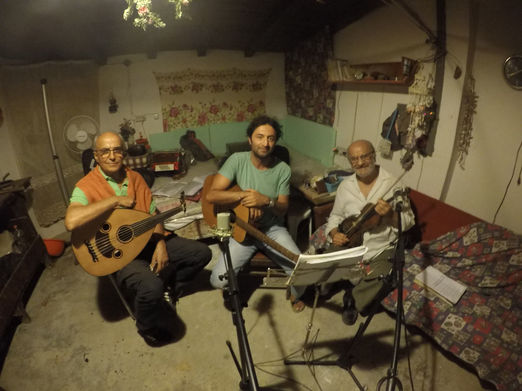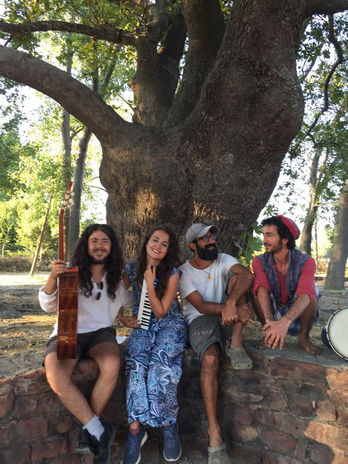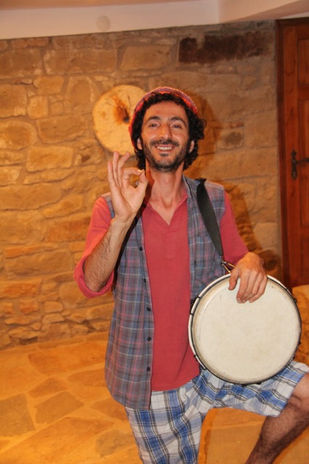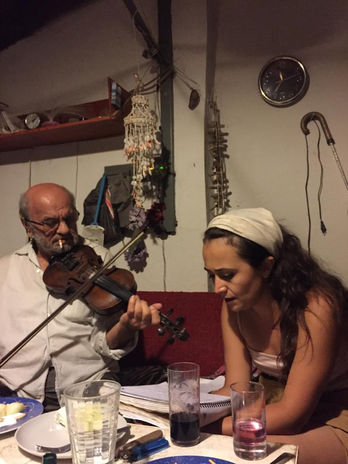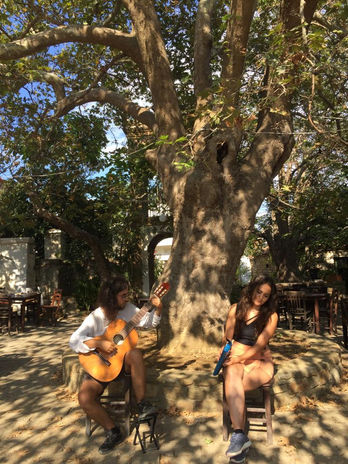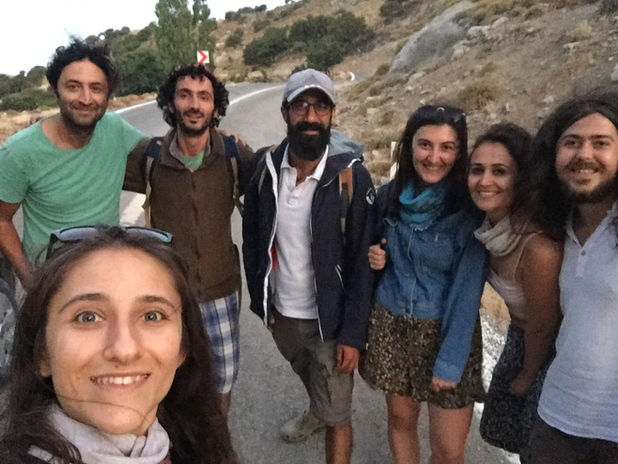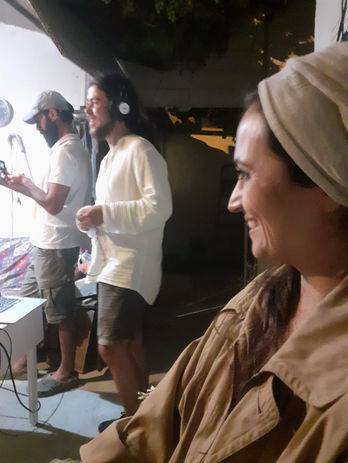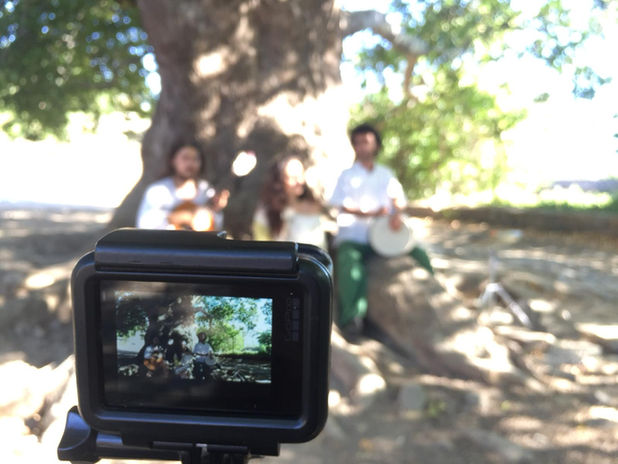
seven plane trees and shadows
"Seven Plane Trees and Shadows" is a project in which eight local pieces played in Imbros (Gökçeada) are performed. Some of the pieces are in common with the region, the others are the pieces of Imbros itself. Compiled by Timoleon Tsakni from Imbros, six of the pieces are performed by Alihan Erdoğan (arrangement, classical guitar, vocals), Emrah Uluğ (percussion) and Ezgi Ceylan (vocals, melodica); two of them are performed by musicians of the island, namely Timoleon Tsakni (violin, vocals), Kemal Yazgan (oud, vocals) and Şenol Aktürk (acoustic guitar, vocals).
Since very few people know the presence of local pieces representing the history and culture of the people living in the island, the aim of the project is to make these works to be heard by a wider audience. Gökhan Fırat and Halil Canbolat are on the camera in this project, where video recordings are made in the shade of six old plane trees in the island.
tsanakkaliotissa.
It is a song played in the Northern Aegean area and chanted with different words in different places. (see Hronis Andonidis-Tsanakkaliotissa)
The changes in the second and sixth degrees of the modal scale have a facilitating role in changing the atmosphere of the piece on a frequent basis.
This modal scale, which Turkish music listeners may be familiar with, are just one of the hundreds of things people share with each other in this land; just like the nine-eighth rhythm of this piece.
agia todoritissa.
A song from Agia Todori* -today known as Zeytinliköy-. It is a nine-eighth piece in classical binary form. The lyrics were written by Timoleon Tsakni. Since it is also a piece which tempts people to dance, a section apart from the theme is included at a point in the piece, containing local motifs and rhythmic accents. This section is inspired by the performances of Timoleon Tsakni himself.
* a village in Imbros.
kayikaki.
An Imbros piece winking at the barcarolles* with its three-quarter meter and as well as its lyrics, which reminds of a boat "sailing in a heaving manner in the sea of love". Rewriter of the piece in Turkish is Kemal Yazgan. We added improvised parts to the beginning and the end of the piece, allowing us to express personal associations. The piece also gave its name to a documentary focusing on the life story of Timoleon Tsakni and Kemal Yazgan in relation with Imbros (see Kayikaki-A. Kadir Ruşen.)
*It is a genre that originally expresses the songs sung by Venetian gondoliers and has become common for Western music over time.(see Agustin Barrios Mangore-Julia Florida or Stavros Xarhakos-Varcarolle)
treis filoi.
Treis Filoi, in accordance with its name, was performed by three friends of Imbros. Although the piece is played and sung in Imbros, it owns a narrative focused on the individual rather than the place or the society. The narrative in the piece ends at one point; but many details in the story remain ambiguous.
apo to skinoudi.
It narrates a love story set in Skinoudi* -today it is known as Dereköy-. It contains classical cultural motifs such as the coy lover, who is seen at the window and fallen in love with, the scaly handkerchief, etc. There is also a dialogue part in the piece reminding us of müracaa ghazal** poems, Nikos Douldouris translated it for us like this:
- My girl! Won't you sell your olives to me?
You show them only to torture us?
-I will neither lend nor sell,
I keep them only to torture you.
The modal scale to which the piece belongs is used to create a contrast between the melody (a) on which the lyrics are chanted and the interlude (b). The contrast between this "a" and "b" parts is not only related to the scale used, but also to the rhythmic motifs. This is a feature we could also see in other Imbros pieces. (see Konto to Fistanaki Sou)
*a village in Imbros.
**In Persian, Arabic, and Turkish Classical Divan poetry, the ghazal consisting of dialogue between lovers and the beloved, which is woven with lines starting with "I said- z said" (See Hafez-Toranj or Şeyhî-Didüm Visâline.)
pekse kati gia me.
“Play something for me, my gipsy violinist
Every string you pull brings me a consolation”
It is penned with the common understanding that the heartbroken lover expects help from the music and the musician. Just like Melquiades in One Hundred Years of Solitude, the gypsy violinist has an almost lofty position in this piece. It is such a melody that can be called into existence from nothing by the violinist. Thus it will give hope and consolation to the lover and heal him.
Pekse Kati Gia Me-Lyrics&Translations
Pekse Kati Gia Me-Sheet Music
konto to fistanaki sou.
The song promises its audience a tour of Imbros, with the names of the local regions it includes. At the same time, it brings many different details about Imbros to the surface. For example, plants such as chaste and marjoram have become a part of this piece, just as they are the inhabitants of the island. Another remarkable detail is the narration of the beloved one offering her lover the water that she pours from the priest's fountain to the jug, and the lover getting drunk without having to drink because it consists of common elements with the narratives of other neighbouring communities. This part also shows parallelism with the theme of "loves growing around the fountain", which is common in Anatolia. Again, as can be seen in the equivalent works in Anatolia, the piece is dominated by a Karacaoğlan-like male gaze, watching after the lover. A look that praises, idealizes, but sadly passivates while blessing.
Konto to Fistanaki Sou-Lyrics&Translations
Konto to Fistanaki Sou-Sheet Music
ego to pino.
Another piece in common with the region (see Vichy Moscholiou-Ego To Pino). It is not a kind of song that calls for dancing. Instead, it is listened when people gather around a table. It is a piece that is chanted from the mouth of the drunken lover, which is more about the sad and, on the other hand, the enthusiastic side of love. The lover is "swaying" between ecstatic renunciation and passion during the song. The piece is often performed rhythmically flexible, perhaps referring to this state of "wobbling". (see Stratos Pagioumtzis-Ego to Pino).
Ego To Pino-Lyrics&Translations
Ego to Pino-Sheet Music
credits and thanks
acoustic guitar, vocals: Şenol Aktürk
camera: Gökhan Fırat
camera (drone): Halil Canbolat
classical guitar, vocals, arrangement: Alihan Erdoğan
violin, vocals: Timoleon Çakni
oud, vocals: Kemal Yazgan
percussions: Emrah K. Uluğ
vocals, melodica: Ezgi Ceylan
endless thanks to Nikos Douldouris, Stefani Kılçıksız, Arek Bogosyan, Hakan Meral, Mücahit Uğur, Özlem Kılkış, Seda Çıkrıkçı, Simge Demiral and Ümmühan Batu.






